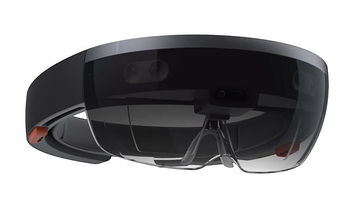Difference between revisions of "Microsoft HoloLens"
Xinreality (talk | contribs) |
Xinreality (talk | contribs) |
||
| Line 17: | Line 17: | ||
|Display= | |Display= | ||
|Resolution= | |Resolution= | ||
| + | |Pixel Density= | ||
|Refresh Rate= | |Refresh Rate= | ||
|Persistence= | |Persistence= | ||
Revision as of 22:13, 27 August 2015
| Microsoft HoloLens | |
|---|---|

| |
| Basic Info | |
| Type | Augmented Reality |
| Subtype | Optical head-mounted display |
| Platform | Windows Holographic |
| Creator | Alex Kipman |
| Developer | Microsoft |
| Manufacturer | Microsoft |
| Website | Microsoft HoloLens |
| Requires | Nothing |
| System | |
| Operating System | Windows 10 |
| CPU | Intel Cherry Trail Atom |
| GPU | Intel Cherry Trail Atom |
| HPU | Holographic processing unit |
| Storage | |
| Display | |
| Image | |
| Field of View | Small (30° by 17.5°?) |
| Optics | |
| Optics | ?? |
| Tracking | |
| Tracking | 6DOF |
| Rotational Tracking | IMUs |
| Positional Tracking | Depth Camera with 120°×120° FOV |
| Audio | |
| Audio | Spatial Sound |
| Connectivity | |
| Device | |
| Input | Gaze, Gesture, Voice |
Microsoft HoloLens is a Augmented Reality device developed by Microsoft. It is part of the Windows Holographic AR Platform incorporated wtih Windows 10 OS. Similar to other OHMDs, HoloLens is a see through display worn over your eyes. Unlike Oculus Rift and VR Devices, the eye-piece component of HoloLens is transparent and the headset requires neither PC nor smartphone. It is able to project high-definition virtual content or holograms over real world objects.
Microsoft HoloLens runs a self-contained Windows 10 computer. It features HD 3D optical head-mounted display, spatial sound projection and advanced sensors to allow its users to interact its AR applications through head movements, gestures and voices.
HoloLens was announced in Windows 10 Event on January 21st, 2015.
Contents
Hardware
Display and Sound
The smartglass head-mounted display requires neither cords nor phones. It features a HD 3D optical head-mounted display, spatial sound system along with various sensors. The eye-piece consist of a tinted visor with a pair of combiner lenses within. 2 small speakers are located on the sides of OHMD. Unlike headphones, these speakers do not prevent the user from hearing external sound.
The field of view where the holograms appear is quite small, estimated to be 30° by 17.5°.
Sensors
Sensors include head tracking IMUs, sound capture system consist of various microphones, an energy efficient depth camera with 120°×120° FOV and a RGB video camera.
Processors
For processors, in addition to CPU and GPU, HoloLens will possess an HPU, holographic processing unit. HPU is a coprocessor that is dedicated to integrating real world and virtually generated content. It consolidates and processes all the data from various sensors and produces a thin stream of useful information to the other processors. HPU removes the burden of handling heavy external data from the CPU and GPU, allowing them to focus on creating content.
HPU - processes all of the data from its sensors, depth camera, microphone etc.
Input and Interface
A pair of buttons responsible for brightness is above the left ear while another pair of buttons responsible for volume is above the right ear. In each pair, one of the buttons is concave while the other one is convex.
5 LEDs are present on the left side of the OHMD. These LEDs display various system statuses such as power and battery conditions. A microUSB port is present for charging and connection.
Setup Tutorial
Features
Anchor holograms onto real life objects. Virtual objects are projected at about 60 cm (near plane) to few meters.
Spatial Mapping - scans the environment in real time to create a mesh of an X/Y/Z coordinate plane. Objects can be accurately projected into the mesh.
Gaze Recognition - Air Tap
Commands
HoloLens tacks your gaze. When you perform a gesture such as air tap, look at the part of hologram where you want to place your tap.
Gesture
| Action | Description | Effect |
|---|---|---|
| Air Tap | With your index finger pointed upward, bend it forward | Simulates a mouse click in a desktop environment. Activates the interactive component |
| Home/Start | Opening your hand with palm facing up | Simulates the Windows key on a keyboard or Home button on a Windows Tablet. Opens up the holographic start menu. |
Voice
| Action | Effect |
|---|---|
| "Follow me" | The window follows the user, along the wall. |
Apps
HoloLens can project various Windows 10 Apps, programs and browsers onto walls and other objects. One of the example Microsoft used was Windows-like interfaces were projected onto walls and furniture. Users can interact with these projections with gaze, gestures and voice commands.
Holo Studio allows the user to create 3D models used for 3D Printing. In addition to gesture commands it allow accepts voice commands.
Minecraft is a Augmented Reality version of Minecraft.
Developer
Windows Holographic is Microsoft's AR platform incorporated in Windows 10 OS. Windows Holographic API is implemented in all devices running Windows 10 including smartphones and tablets.
History
January 21, 2015 - Microsoft HoloLens was officially announced.
April 28, 2015 - First live stage presentation of the HoloLens.